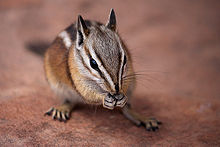Uinta chipmunk
| Uinta chipmunk | |
|---|---|
 |
|
| Scientific classification | |
| Kingdom: | Animalia |
| Phylum: | Chordata |
| Class: | Mammalia |
| Order: | Rodentia |
| Family: | Sciuridae |
| Genus: | Neotamias |
| Species: | N. umbrinus |
| Binomial name | |
|
Neotamias umbrinus (J. A. Allen, 1890) |
|
| Subspecies | |
|
7 (see text) |
|
| Synonyms | |
|
Tamias umbrinus |
|
7 (see text)
Tamias umbrinus
The Uinta chipmunk, or hidden forest chipmunk (Neotamias umbrinus), is a species of chipmunk, in the family Sciuridae, endemic to the United States. Formerly known as Tamias umbrinus,phylogenetic studies have shown it to be sufficiently distinct from the eastern chipmunk as to be placed in a separate genus, Neotamias. The same studies have also suggested that Palmer's chipmunk may actually be a subspecies of Uinta chipmunk, although the two are still generally regarded as separate species.
The Uinta chipmunk is a medium-sized chipmunk, with adults ranging from 20 to 24 cm (7.9 to 9.4 in) in length, including the tail at 7 to 11 cm (2.8 to 4.3 in), and weighing an average of 67 g (2.4 oz). The predominant color of the summer coat varies from yellowish brown-grey to dark brown, often with a reddish tinge. Three wide, distinct dark blackish-brown stripes run down the back, separated and surrounded by four paler stripes of pale grey to white fur. Also, three dark and three pale stripes are on each side of the face. In the winter, the coat becomes duller and more greyish, and the stripes become less distinct. The ears are black, and the underparts a very pale grey. The tail has orange and black fur, with a paler fringe of hair on the underside.
The Uinta chipmunk lives in montane and subalpine forests of the western United States, between 1,400 and 3,650 m (4,590 and 11,980 ft) elevation. It is most common at the margins of pine and fir forests, or in clearings, often near rocky terrain or steep slopes. Uinta chipmunks do not have a continuous, unbroken range, but are instead found in a number of disjunct localities, perhaps reflecting changing patterns of forest cover during the . Seven subspecies are currently recognised:
Uinta chipmunks are herbivorous. Their primary diet consists of the seeds of coniferous trees such as Douglas fir, ponderosa pine, juniper, and spruce, and on the fruit of local shrubs such as wild roses, raspberries, and chokecherries. They also eat some grass and fungi, and may supplement their diet with small quantities of insects or carrion.
...
Wikipedia

